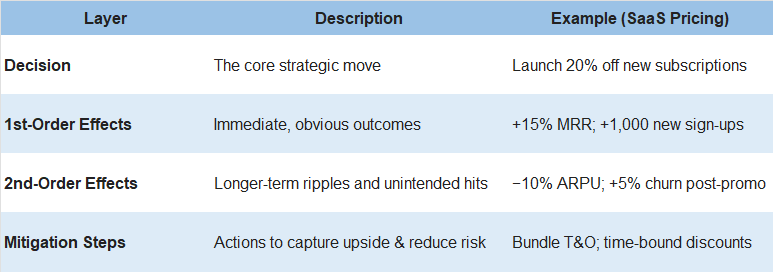Second-Order Thinking: A Super Useful Mental Model for B2B Growth
How Second-Order Thinking Drives Strategic B2B Growth and Competitive Advantage
What feels like a smart investment today may become a burden tomorrow. In general, decisions that look like victories in the moment can quietly turn into setbacks down the line.
Second-order thinking is the practice of looking beyond immediate outcomes to anticipate indirect, delayed, and compounding effects of decisions.
What is Second-Order Thinking?
Second-order thinking is a mental model, a practice of looking beyond immediate consequences to anticipate the indirect, delayed, and compounding effects of decisions. Instead of asking “What happens now?”, it asks “What happens next—and then what?” This deeper layer of analysis helps avoid unintended consequences and uncovers hidden opportunities.
This mental model can be applied in our everyday life.
Here is a everyday example.
Imagine you decide to eat a unhealthy snack, when you’re hungry:
First-order: You satisfy your hunger instantly.
Second-order: You gain a few grams of weight, feel a bit sleepy, and postpone an important task.
Third-order: After weeks of daily that snack, your clothes no longer fit and your project deadlines slip.
Fourth-order: Over years, you face health issues, incur medical costs, and compromise long-term goals.
In today’s hyper-connected, fast-moving marketplace, second-order thinking gives leaders the X-ray vision to spot hidden risks and opportunities beyond the obvious.
For example, the Transformative Innovation Policy Consortium (TIPC) ran a dedicated Second-Order Learning (SOL) research project during the COVID-19 pandemic. Between May and December 2020, TIPC—led by Alejandra Boni of INGENIO (CSIC-UPV)—brought together diverse researchers and practitioners to reflexively explore how the crisis acted as a landscape shock, driving double-loop learning that challenged core assumptions and informed sustainability transitions.
In business, when you’re tempted by a quick ROI from a new technology rollout, a market expansion, or a cost-cutting reorg, it’s easy to cheer the immediate gains and ignore the domino effects—rising vendor lock-in, shifting customer expectations, or internal culture stress. By mapping out those ripples two, three, or four steps ahead, you safeguard against unintended blowbacks, strengthen stakeholder trust, and craft strategies that hold up under tomorrow’s pressures. In a world where yesterday’s breakthrough can become today’s liability, that long-game perspective isn’t optional—it’s your competitive lifeline.
Netflix Example
In 2011, Netflix announced a plan to split its DVD and streaming services under a new brand (“Qwikster”). First-order thinking focused on operational clarity. Second-order thinkers anticipated brand confusion, subscriber backlash, and accelerated churn. Recognizing these ripple effects, Netflix rapidly reversed the decision—preserving customer trust and averting a deeper crisis.
When to use Second-Order Thinking in Business?
There are innumerable scenarios for applying the second-order thinking in Business. To get started, here are a few important business decisions where it comes handy.
Major pricing changes (to foresee churn, brand impact, upsell potential)
Product launches (to anticipate support, training, and ecosystem effects)
M&A and partnerships (to map cultural integration, regulatory scrutiny, and talent shifts)
Technology rollouts (to identify data, security, and change-management implications)
History of Second-Order Thinking
The concept of looking multiple steps ahead was formalized in investing circles by Howard Marks in his book The Most Important Thing (2011), where he calls it second-level thinking. Shane Parrish later popularized it under the name “second-order thinking,” crediting thinkers like Ray Dalio and Charlie Munger for championing the mindset of “And then what?”.
Many iconic leaders like Jeff Bezos, Warren Buffett, Charlie Munger, Bill Gates, Elon Musk and Steve Jobs embed this mental model into their decision processes.
Business Scenario Application
Decision : You roll out a 20% discount on your core subscription plan to accelerate sign-ups.
First-Order Effects
Surge in new customer acquisitions
Quick uplift in MRR (monthly recurring revenue)
Second-Order Effects
Margin compression as discounted seats lower average revenue per user (ARPU)
Existing customers feel slighted, increasing support tickets and complaints
New customers sign up for the discount only, then churn when price resets
Premium tiers lose appeal if the lower tier offers too much value, stunting upsell growth
Mitigation (via Second-Order Thinking)
Time-box the discount and communicate clear end dates to preserve ARPU
Bundle value-add services (onboarding, training) to offset margin impact
Introduce “discounted” and “core” cohorts in billing systems to monitor churn difference
Use this simple structure for any of your important decision (given with above example):
Is there a Third-Order Thinking?
Third-order thinking moves beyond first-order (immediate outcomes) and second-order (downstream ripples) to examine how systems themselves evolve. It asks: when our actions reshape the broader landscape, how do new rules, norms, and networks emerge as a result?
Let's take the example of automating a production process.
First-Order: Production speed doubles.
Second-Order: Headcount falls, upskilling on automation becomes a priority.
Third-Order: Vocational schools revise curricula, trade unions lobby for new labor laws, and aftermarket service providers reinvent subscription models to support advanced robotics
Do you need professional help in this area?
Reach out to us at Business.Support@collaborat.com.
Read More
Read past issues of this fortnightly editorial here.
As always, happy to hear your views in the comments.


